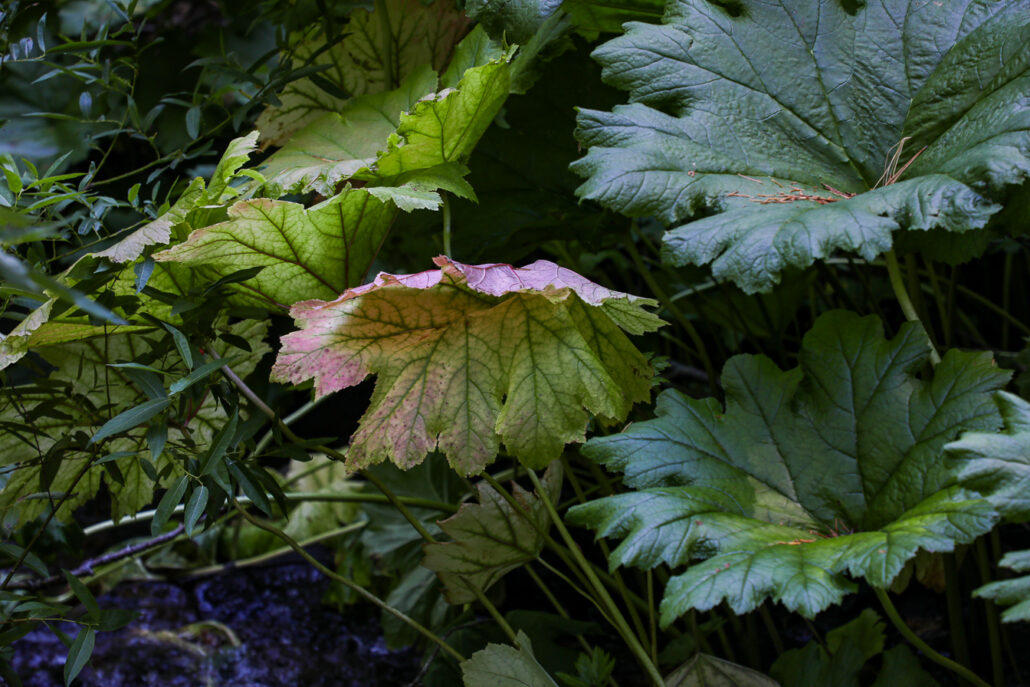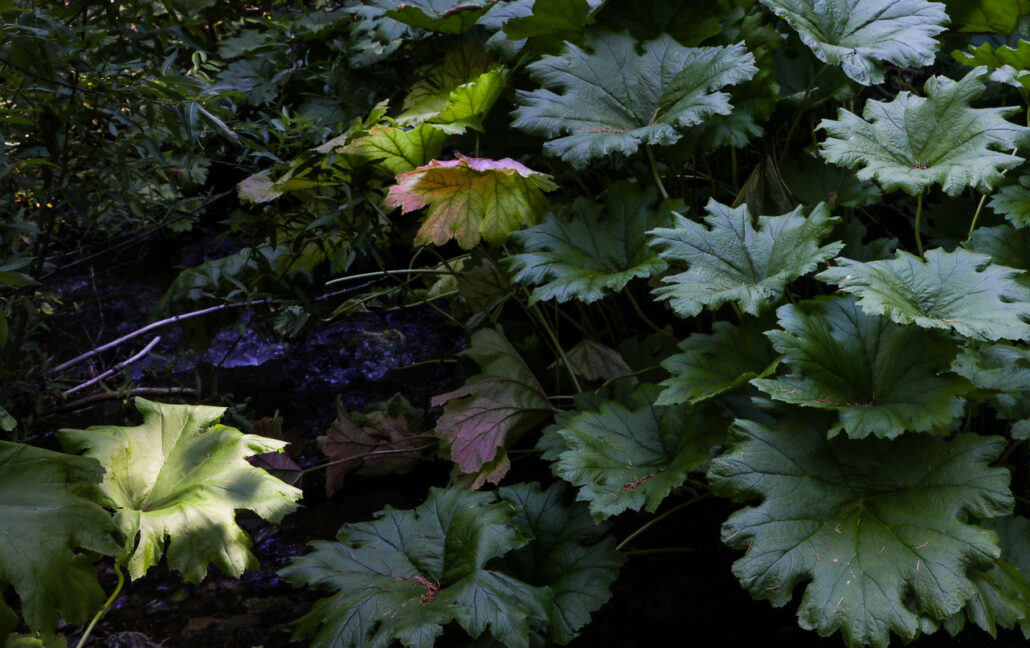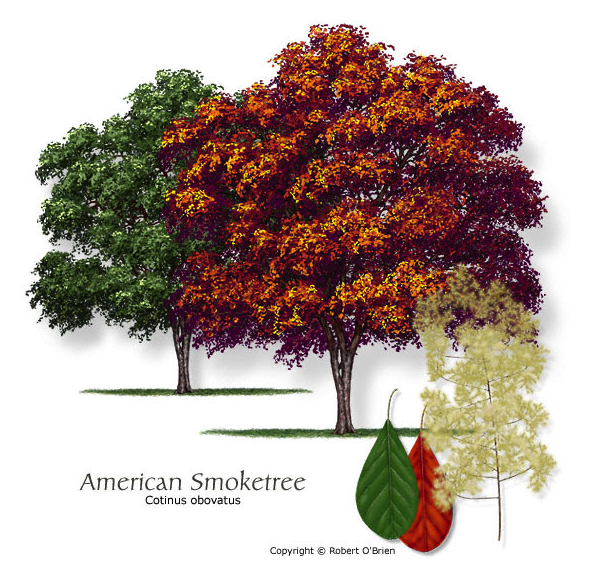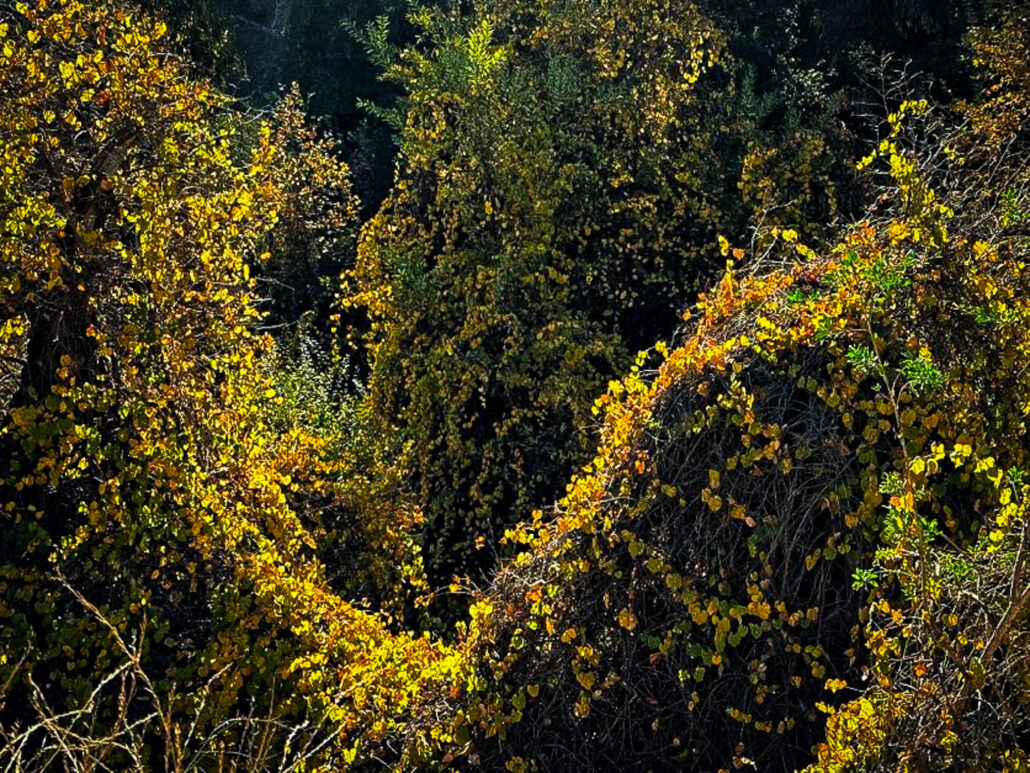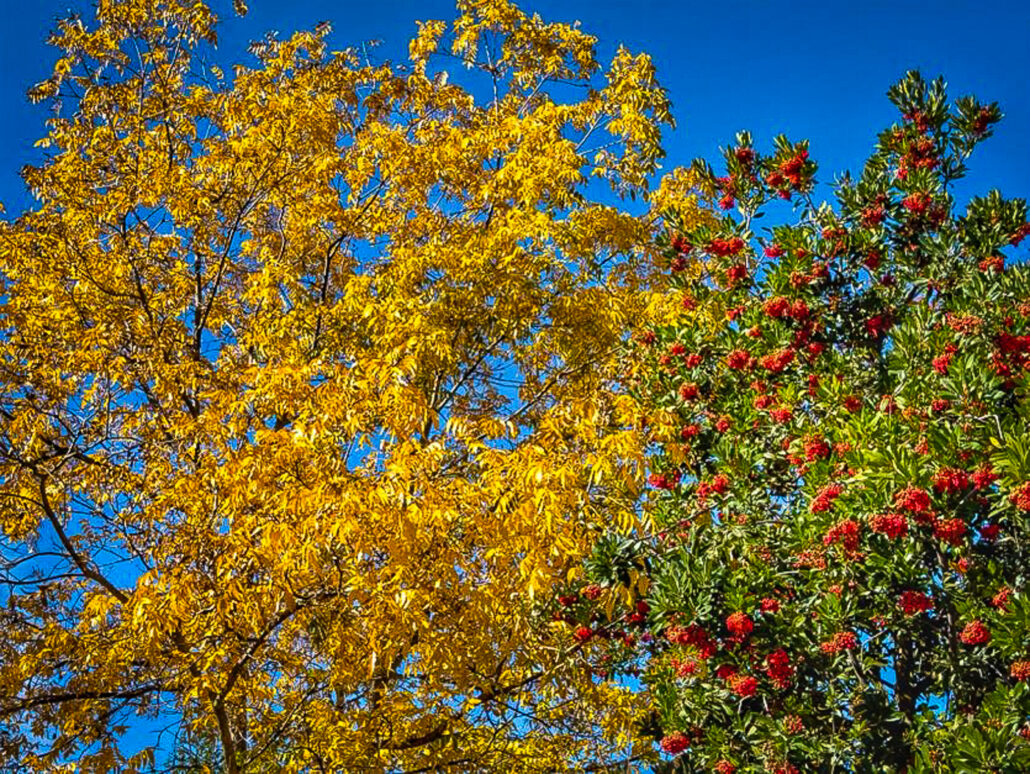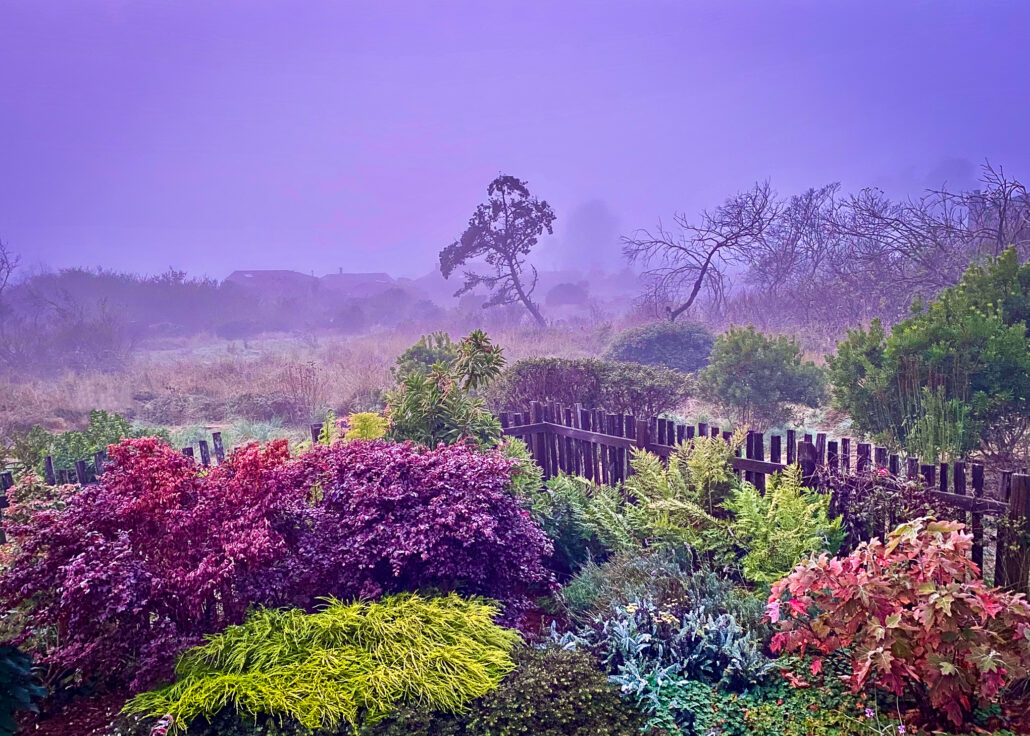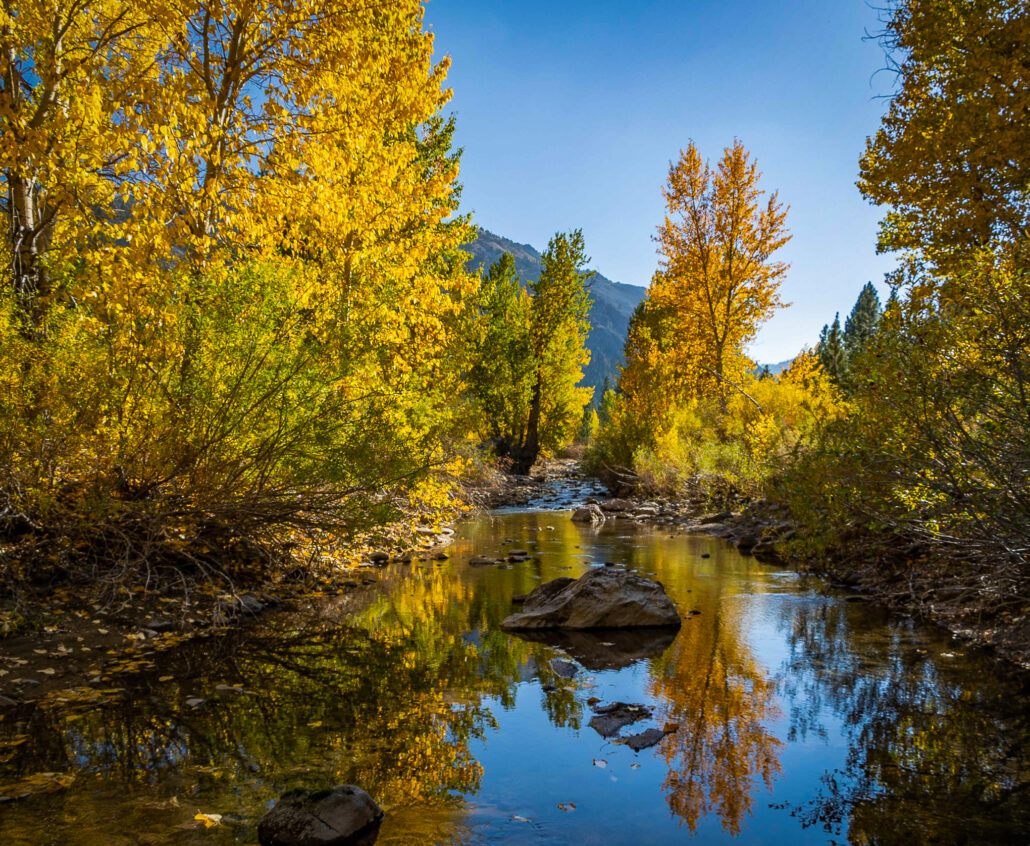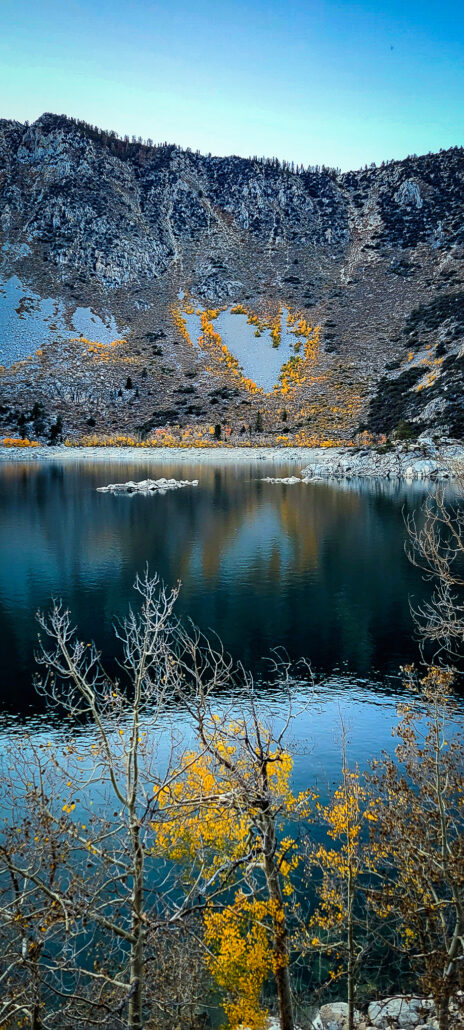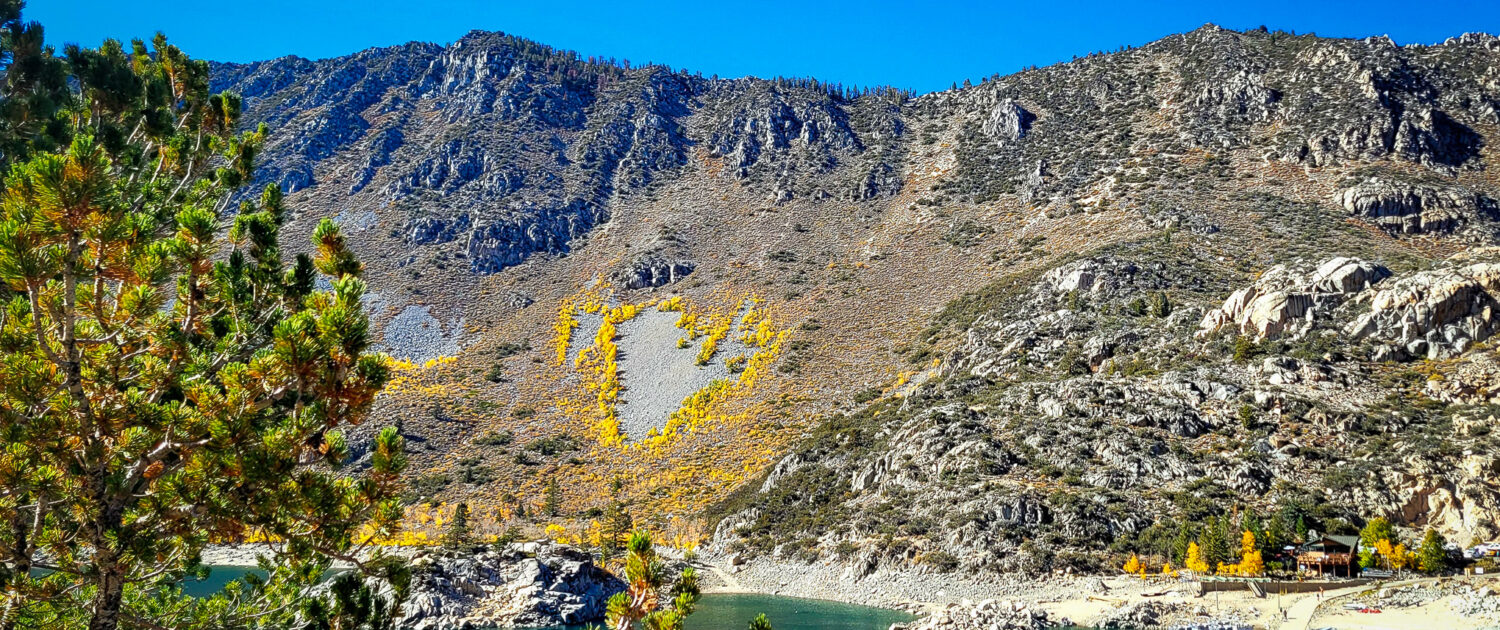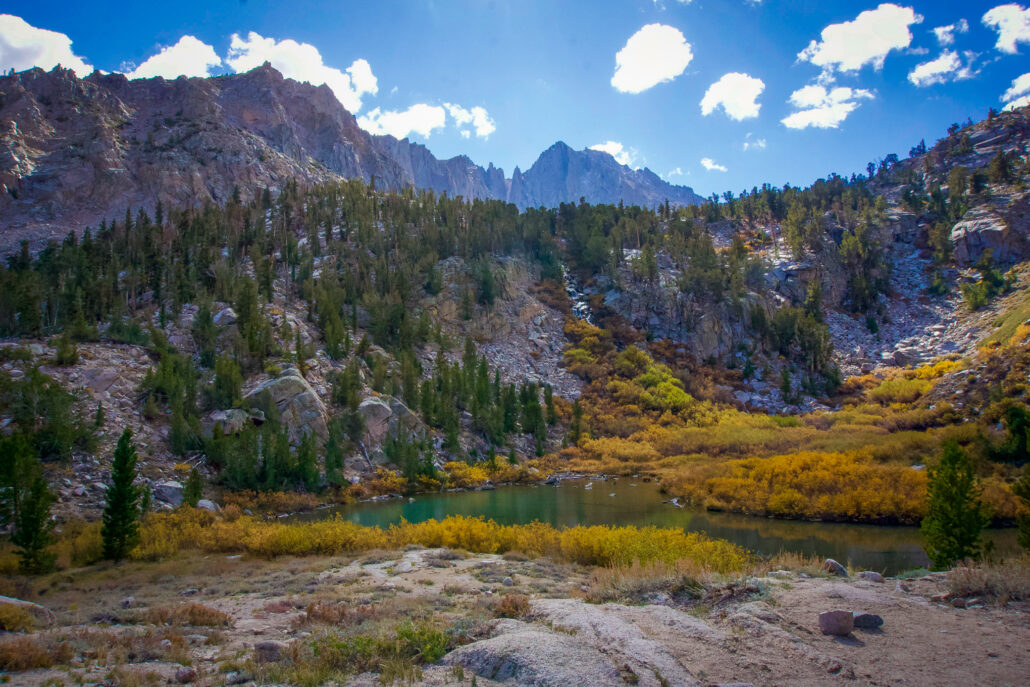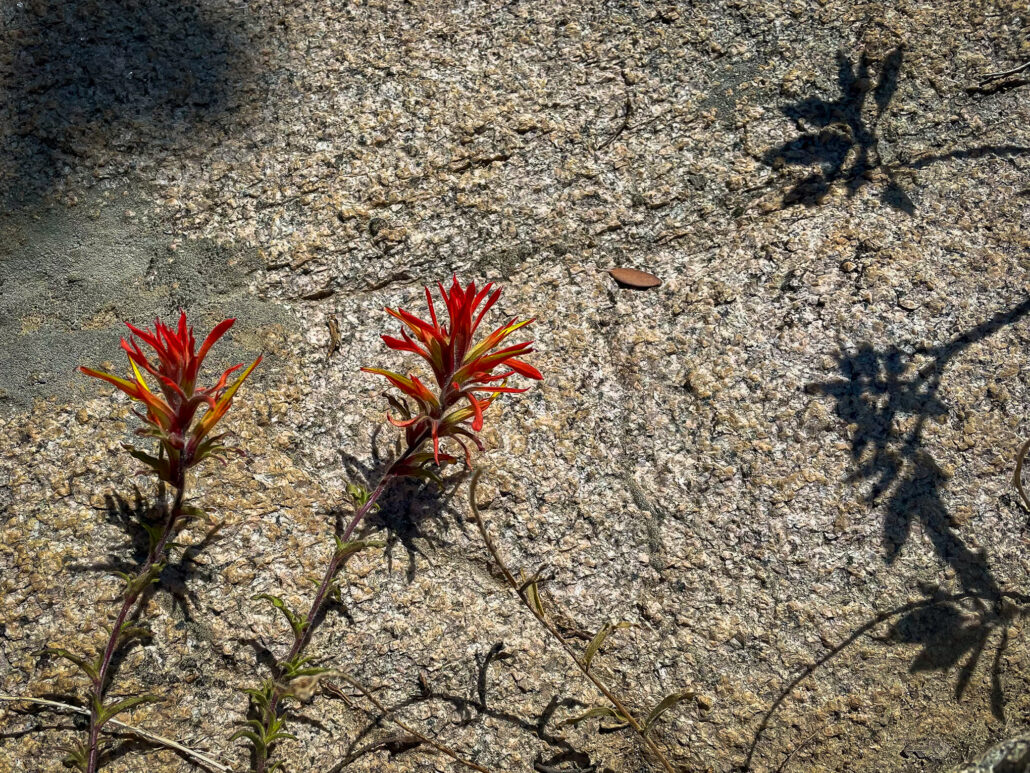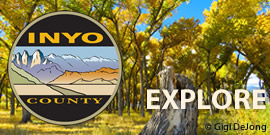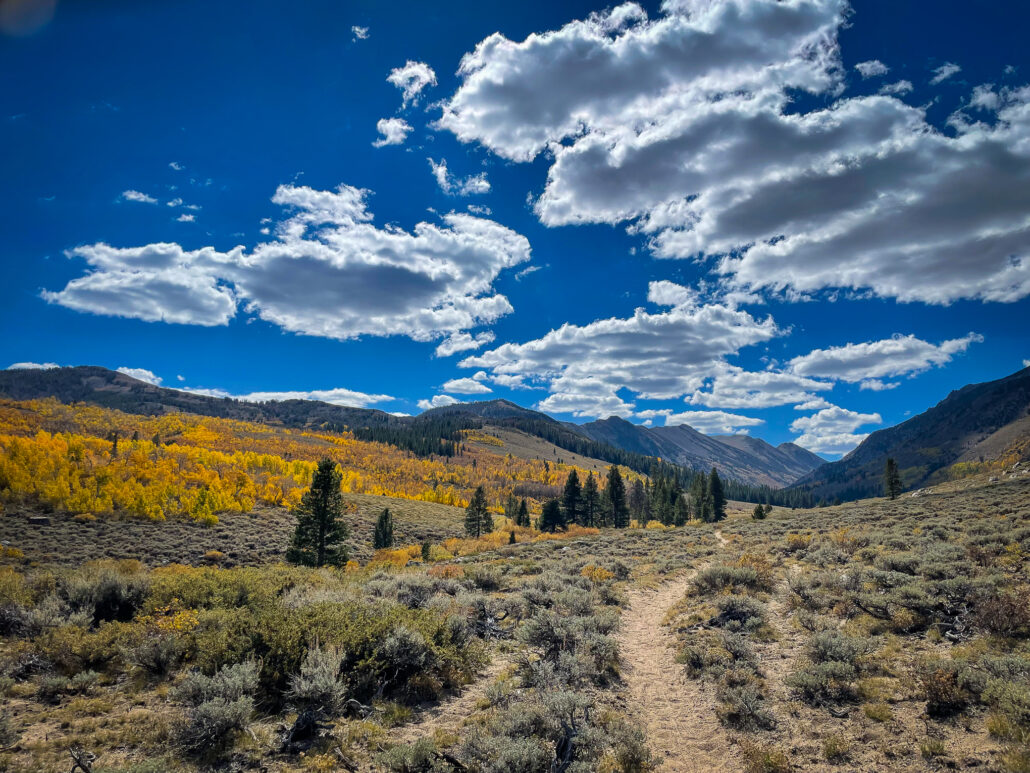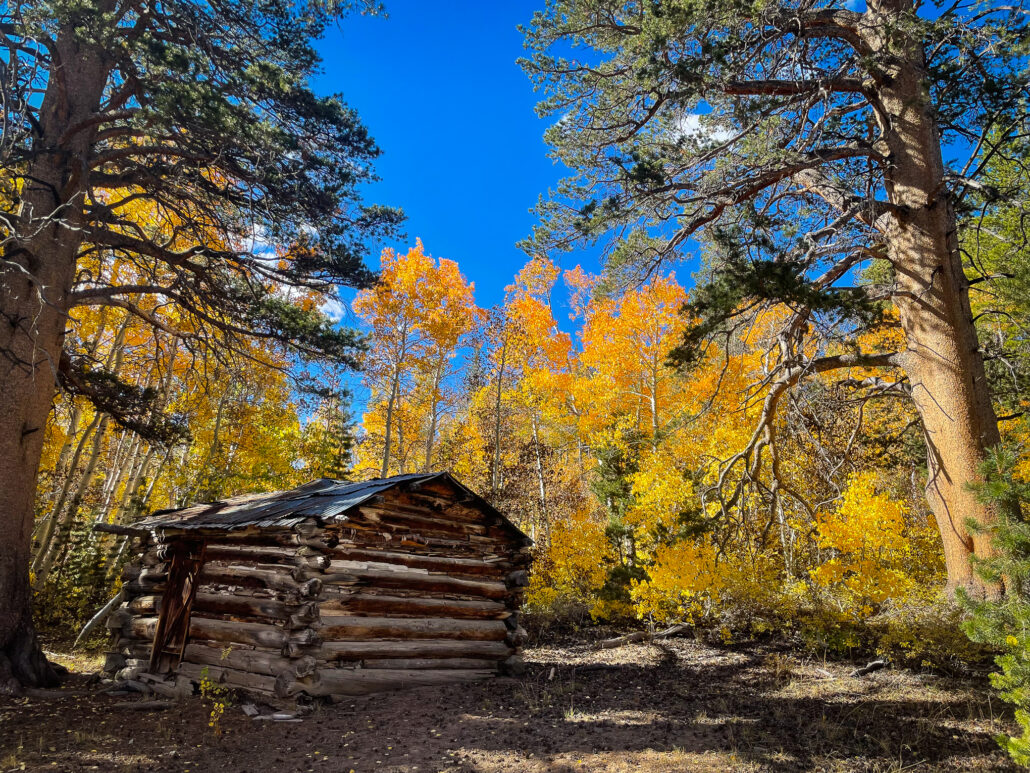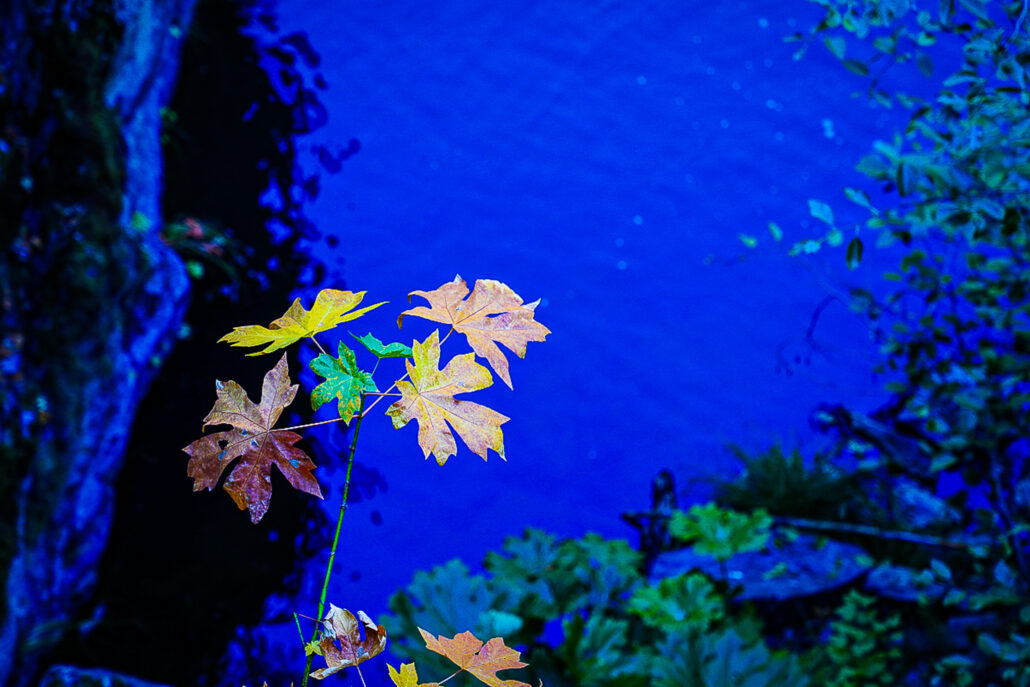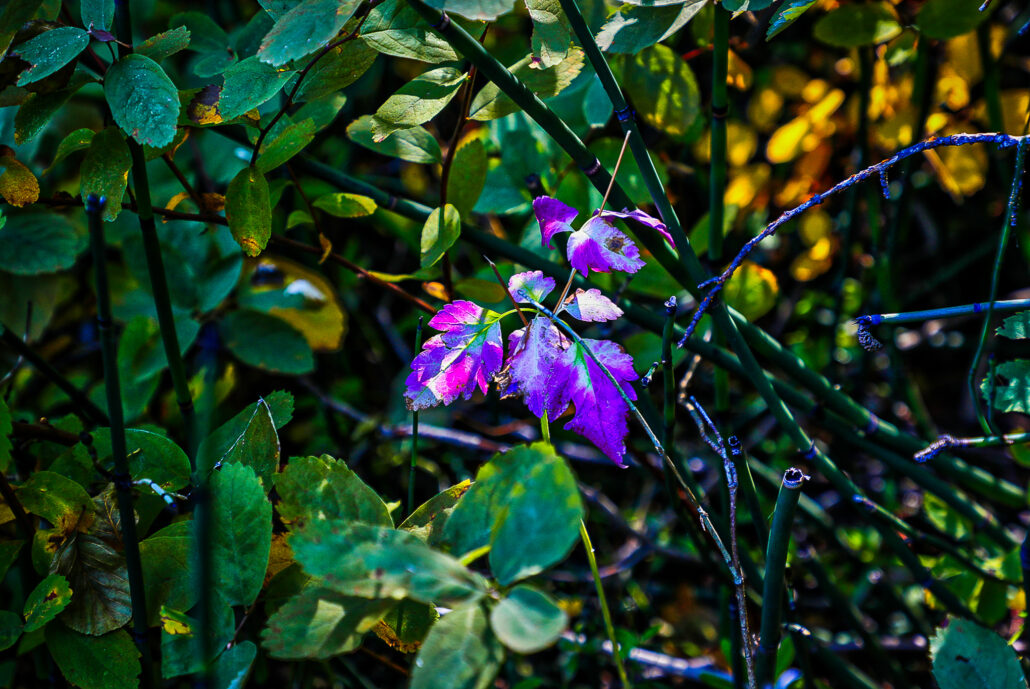Early Signs of What’s to Come
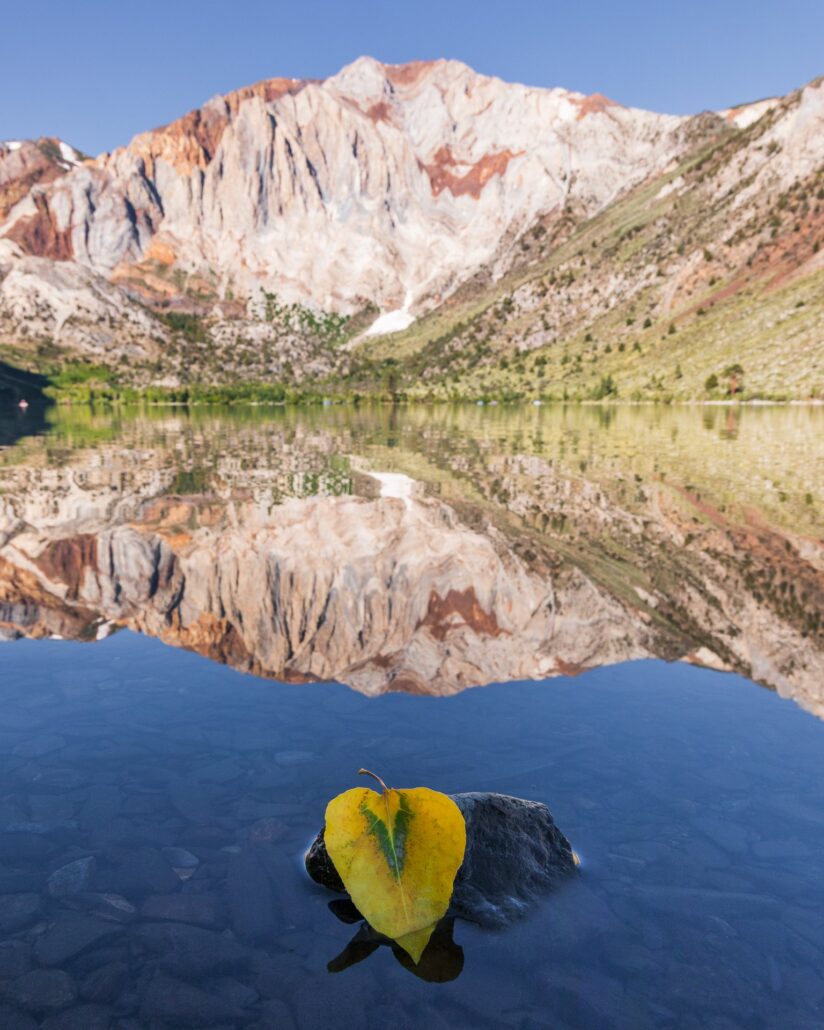
Color spotters in California are beginning to send in sightings of the first signs of seasonal color change.
In the Mammoth Lakes area, Angie Plaisted reported on August 24, 2023 that a few leaves around Convict Lake were getting an early start on showing off their fall colors.
Color spotter Samantha Lindberg also checked out Convict Lake on August 28 and claimed, “we are just starting to get a teaser of what is yet to come, Convict Lake has some yellow on the tops of the tress and some fallen leaves. Also, the rabbitbrush is making its appearance!”
Rabbitbrush appears as summer begins to fade and blooms into fall.
Color spotter (and former californiafallcolor.com editor) John Poimiroo reported on August 25 that signs in Tahoe at 6,224′ were pointing to an early winter in the High Sierra.
“Oak trees are full of acorns and dropping them rapidly,” Poimiroo said. “Chickaree (Douglas Squirrels) and Golden Mantled Ground Squirrels (often mistaken as chipmunks) are frantically gathering black oak acorns and other nuts. One local said she had never seen them so active.”
US Forest Service Botanist Blake Engelhardt also weighed in with some thoughts.
“I’m optimistic that with the lingering snowpack this season and the moist soils from spring rains, we are primed for some good fall colors,” she said.
The Farmer’s Almanac is calling for another big winter and Engelhardt reinforced that it could quickly change what we see out there this year.
“Foliage season is always difficult to predict in terms of length, as unexpected frosts can cause leaves to drop quickly.”
This year the first day of fall is September 22 at 11:49 pm, so start your preparations for scenic drives and sweater weather.
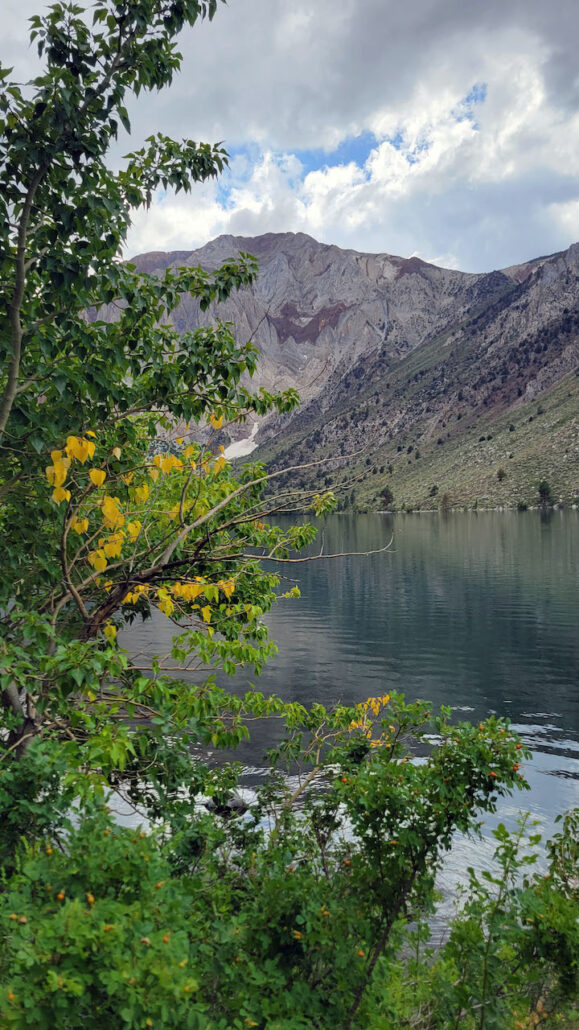
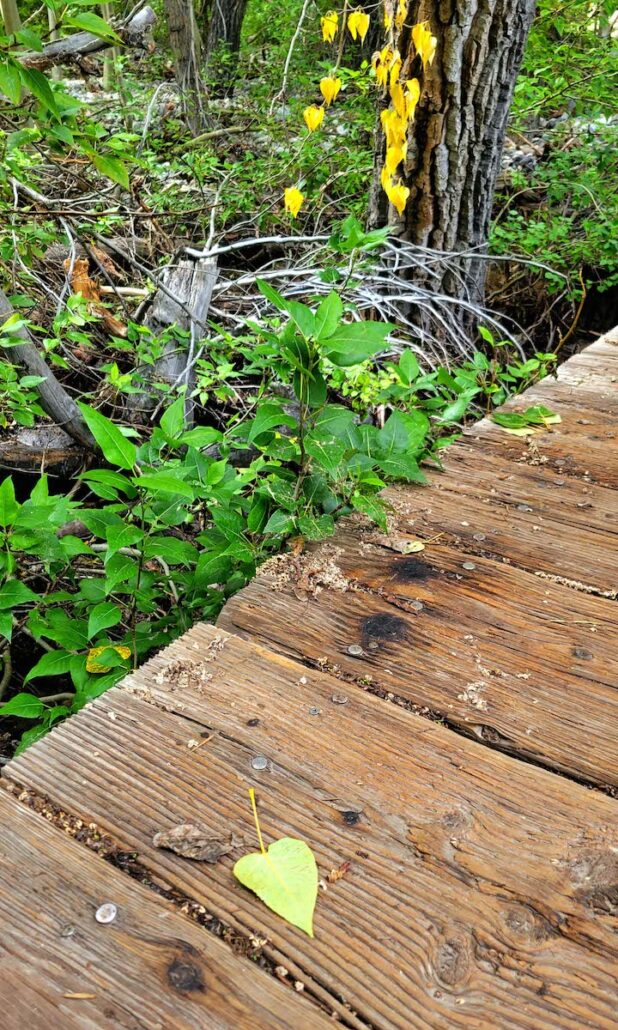
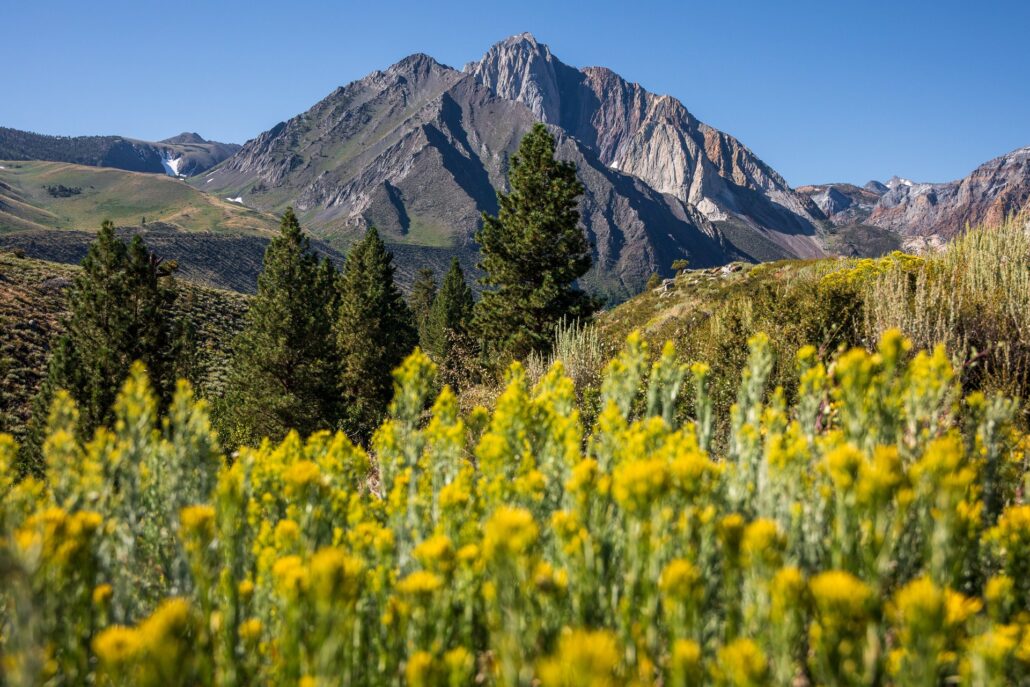
Texas Peaks
The internet has been abuzz with reports of an unexpected December display of peak fall color in north and central Texas.
The Texas A&M Forest Service had predicted fall colors to be muted this year, due to drought. Though, a wet August is said to have given new vibrance to Texas’ show.
Photographs on the Web show dark red, carnelian, orange and gold trees. Many species are contributing to the display, including such Texas natives as American smoketree, bigtooth maple, Graves oak, Huisache, Possumhaw, Prairie sumac, Texas redbud, Texas red oak and white ash.
To see what they’re reporting in Dallas, CLICK HERE.
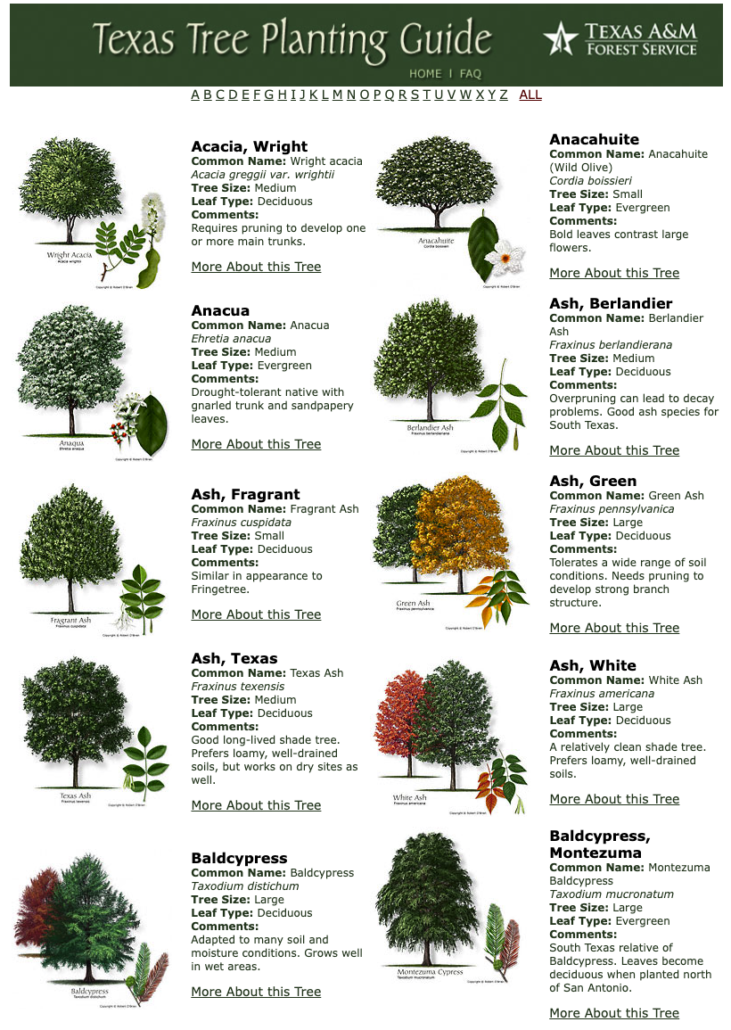
Sycamore Canyon
Q. What does the Botanical Information Consultant of the Los Angeles County Arboretum and Botanic Garden do on his day off?
A. He looks at trees.
What Frank McDonough did this past weekend can only be described as a busman’s holiday. He hiked Sycamore Canyon in Whittier on a day off, and when he came upon magnificent examples of California wild grape (Vitis californica), Toyon (Heteromeles arbutifolia), Southern California black walnut (Juglans californica), Frémont cottonwood (Populus fremontii) and California sycamore (Platanus racemosa), he had the presence of mind to photograph and share what he found.
For that, Frank earns a First Report for Sycamore Canyon and our thanks.
Sycamore Canyon is a 3.3-mile out-and-back trail with a gain of 331 feet. It’s considered to be an easy hike. McDonough reported peak fall color throughout much of the trail, making it California Fall Color’s Hike of the Week.
Today, I spoke with Soumya Karlamangla, California correspondent to The New York Times. She observed that Southern California’s autumn color seems more iridescent and apparent than in previous years. She noted seeing vibrant vineyards near Santa Barbara this past week and said several of her SoCal friends believe this autumn stands out from previous years for its brilliance. She asked if we have any explanation.
I replied that this autumn has benefitted from mild weather (few storms and light breezes) that allowed foliage to retain their fall color. Cool nights and warm days have also combined to intensify color change. This has been common statewide.
Presently, both Los Angeles County and the San Francisco Bay Area are showing beautiful color, as McDonough has illustrated in his photos of Sycamore Canyon and the LA County Arboretum and Botanic Garden in Arcadia.
- Sycamore Canyon, Whittier (318′ – 945′) – PEAK (75-100%) GO NOW!
Purple Haze
“Excuse me while I kiss the sky,” Jimi Hendrix might have sung as he watched a fog bank drop a purple haze over Sea Ranch on the Sonoma Coast this past week.
With such a color, Hendrix would have continued, “things just don’t seem the same,” though they are, Parrish Todd reported.
In Todd’s Sea Ranch garden, purple/burgundy loropetalum, chartreuse golden breath of heaven and orangy oakleaf hydrangea lend their exotic fall colors to the scene.
- Sea Ranch, Sonoma County (108′) – Near Peak (50-75%) Go Now.
Carson River Chronicles
There’s usually no lack of photographs submitted from the Hope Valley. This year, not so much.
That surprised Mark Hoshovsky, though he thought it might be because the Hope Valley looked short of peak when he visited this week … perhaps an explanation.
We disagree. The Hope Valley seems to be peaking normally. Peak began, as it usually does, near the Wylder Resort, with trees in the higher groves soon past peak. Others there have been peaking stand by stand … ordinary for Wylders. The other prime locations in Hope Valley have been developing as they usually do, as well.
It is west of Woods Lake on CA 88, where the color has been disappointing and less than previously recorded.
So, Hoshovsky took a different path. He chronicled the West Carson River near the Wylder Resort, then hiked up toward Luther Pass (CA 89) to Scotts Lake and back through Big Meadow. He was impressed by the scenery on the way to Scotts Lake, along a trail that passed through “lots of aspen, plus some huge trees up to 20′ around at their base (Juniper, Jeffrey pine and others).”
His Frostian solution of “taking the path less-traveled by” resulted in him scoring a First Report for the trail to Scotts Lake, as it had not been reported or photographed previously.
Perhaps his experience explains why fewer photographs from Hope Valley have been submitted this year … color spotters are looking for new places to explore and chronicling less-traveled places, as he did..
- Luther Pass (7,740′) – PEAK (75-100%) GO NOW!
- Scotts Lake (8,022′) – PEAK (75-100%) GO NOW!
- Big Meadow (7,500′) – PEAK (75-100%) GO NOW!
I Heart Sabrina
Little seen or known to most visitors to Lake Sabrina is that a heart of Quaking aspen grows along the hillside to the right (north slope) and behind the store at the lake. You have to be on the south slope looking across the lake, as Angie Plaisted was, to see it.
Angie scores a First Report for being the first color spotter to capture an image of Sabrina’s heart. She accomplished this first at one of the most photographed fall color locations in California.
Fall color is largely Past Peak at Lake Sabrina, but it’s still not without its beauty, as her cell phone images show.
- Lake Sabrina (9,150′) – PEAK to Past Peak, you almost missed it.
Kearsarge Pass
Kearsarge Pass lies on the Sierra Crest at 11,709′ beyond Onion Valley (9,600’). Because Onion Valley usually has disappointing fall color, few collor spotters venture past it in search of autumn brilliance. Soyoung Kim was an exception, posting a First Report for Kearsarge Pass and making it Hike of the Week.
The pass (named after a nearby mine which was named in honor of USS Kearsarge which defeated CSS Alabama during the American Civil War) is a favorite hiking route that travels from Onion Valley in the Eastern Sierra, west to Kings Canyon National Park.
The Onion Valley is at 9,600′ though she found an Indian Paintbrush (Castilleja naja) still blooming at a high elevation. The wildflowers grow up to timberline, attracting hummingbirds to its tasty nectar, so wrote old friends Lynn and Jim Wilson in their guide, Wildflowers of Yosemite.
Quiet Beauty
One of the least visited and most beautiful trails on which to see California Fall Color is the Molybdenite Creek Trail in Mono County. It truly delivers quiet beauty.
Lyle Gordon was there yesterday, and – true to form – he was mostly alone and surrounded by beautiful Near Peak fall color.
Located in the Hoover Wilderness of the Humboldt-Toiyabe National Forest, the 13.8 mile (out and back) trail begins from the Obsidian Campground near Sonora Junction (CA 108) between Bridgeport and Walker. The trails is rated as moderate.
Broad hillsides of peaking aspen are seen from the trail and 2.5 miles up the trail is the Rickey Cabin. Thomas B. Rickey came to the area at the age of 16 in 1852 and later settled as a rancher and sheep herder. 10,126′ Rickey Peak honors his memory.
The land hasn’t changed much from when Rickey lived in the area. Once on the trail, you’re transported back to the late 1800s and its quiet beauty.
- Molybdenite Creek Trail (7,865′) – Near Peak (50-75%) Go Now.

A Cascade of Color
Whenever Micheal Beatley and his granddaughter, Liliana, go hiking, they’re sure to send back colorful remembrances of their hikes.
Yesterday, they hiked the Cascade Trail along Spanish Creek in Plumas County (northern Sierra) where fall colors are Patchy (25% of peak), though it’s also at a low elevation (3,200′).
They were surprised to find Mountain Sweet Cicely (Osmorhiza berteroi) in bloom, a short-lived perennial that grows across both American continents. It loves wooded areas and has a brilliant purple leaf at peak in autumn. In all other seasons, it is forest green.
We usually reserve a First Report for the first report submitted for a given destination, but the vivid purple of Peaking Mountain Sweet Cicely leaves is so rarely seen, that we’re scoring a First Report to Michael and Liliana.
Further, we searched and believe this to be the finest example of Mountain Sweet Cicely’s peak purple color to be found on the internet. Good eye!
- Cascade Trail, Spanish Creek (3,200′) – Patchy (10-50%)
- Buck’s Lake (5,167′) – Patchy (10-50%)


